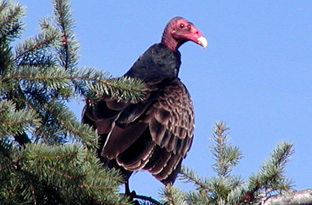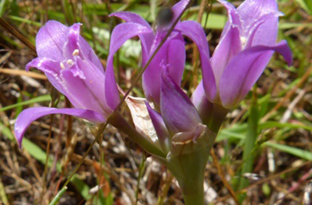
Sparsely Vegetated Ecosystems (SV)
In the Discovery Islands
• Sparsely vegetated ecosystems occur on rocky outcrops, cliffs, talus-boulder slopes or expanses of sand or gravel with thin soil pockets that become moisture-deficient due to rapid drainage and the drying effects of exposure to sun and wind.
• Sparsely vegetated ecosystems have 5-10% low patchy vegetation of small herbaceous plants, mosses, liverworts and lichens; occasional microsites, such as rock crevices with sufficient soil, will support a hardy shrub or tree.
• They include rocky cliff ledges and fissures providing protected habitat for birds, bats, snakes and lizards.
 DIEM has mapped Sparsely Vegetated Ecosystems grey blue in the Sensitive Ecosystems Mapping.
DIEM has mapped Sparsely Vegetated Ecosystems grey blue in the Sensitive Ecosystems Mapping.
Cliffs, rock outcrops, and slabs of exposed bedrock—both coastal and inland—are classified as sparsely vegetated ecosystems due to their very limited patchy soils and flora. In the Discovery Islands, this ecosystem type predominates along many shorelines, where substrates also include talus-boulder slopes and shoreline spits of sand or gravel. Cliffs also occur inland where erosion has carved steep bluffs in the landscape. Here, as on the lower rocky outcrops, soils are usually skeletal and moisture-deficient due to limited inflow of freshwater, rapid drainage and drying, and vegetation is mostly patches of mosses, liverworts and lichens tucked into sheltered depressions.
 Sparsely vegetated ecosystems are challenging environments where plants are slow to establish and easily disturbed. These rocky places are fragile habitat with less than 10% coverage of low vegetation; however, where conditions permit, they support a few wildflowers and even the odd shrub or hardy tree. Ledges and fissures in cliff areas also offer isolated habitat, generally providing protection from predators and they are choice nesting sites for a variety of birds. Steep parts of sparsely vegetated ecosystems provide valuable protected habitat for many small animals, including rare species. Crevices are used by roosting bats and also serve as shelter and overwintering areas for snakes and lizards.
Sparsely vegetated ecosystems are challenging environments where plants are slow to establish and easily disturbed. These rocky places are fragile habitat with less than 10% coverage of low vegetation; however, where conditions permit, they support a few wildflowers and even the odd shrub or hardy tree. Ledges and fissures in cliff areas also offer isolated habitat, generally providing protection from predators and they are choice nesting sites for a variety of birds. Steep parts of sparsely vegetated ecosystems provide valuable protected habitat for many small animals, including rare species. Crevices are used by roosting bats and also serve as shelter and overwintering areas for snakes and lizards.
WHEN YOU EXPLORE sparsely vegetated ecosystems, do your best to prevent disturbance and noise, especially during nesting season from March to August.
Look For Typical & Rare Species in Sparsely Vegetated Ecosystems
NOTE: Sparsely vegetated and herbaceous ecosystems have many species in common.
FLORA Arbutus, blue-eyed Mary, camas (death & common blue), coastal strawberry, common juniper, dune-grass, fragile fern goldenback fern, Hooker’s onion, ladies tresses, lichen species, monkey flower, many-flowered wood-rush, nodding onion, parsley fern, rock mosses, sea blush, sedum, smooth alumroot, yarrow, yellow sand verbena.
FAUNA Alligator lizard, anise swallowtail butterfly, belted kingfisher, black bear, black-tailed deer, cougar, glaucous-winged gull, northern rough-winged swallow, killdeer, little brown bat, pelagic (& /or double-crest) cormorants, peregrine falcon, savannah sparrow, turkey vulture.
SPECIES AT RISK Smooth willowherb (Blue), Queen Charlotte avens (Red), hoary brome (Red), Douglas’ sagewort (Red), peregrine falcon (Blue, Special Concern), Keen’s long-eared myotis (Blue), Townsend’s big-eared bat (Blue)
* For comprehensive species lists & rarity explanation, click here.
Some Observations of Local Species
Turkey vultures
The return in summer to nest in cervices or hollow logs on rocky ledge-habitat. They’re seen soaring above open areas in search for carrion prey.
Killdeer
The killdeers’ piercing alarm call is intended to lure predators from the nest sites as adults alternately cry, pose with broken-wing and run away from danger across open areas. Nests are set in open ground, often far from water.
Pelagic cormorants
They perch and nest on cliff sites beside the sea. In some areas their eggs and young in the nests are attacked by predatory eagles and gulls, thus in these areas few young are fledging.
Alligator lizard
Canada’s largest lizard, may be up to 25 cm total length and can tolerate cooler more humid climates than most lizards. Protecting the rocky outcrop and forest edge habitat where they are seen is important as lizards repeatedly use the same habitat. They select sites that are the most protective and climatically appropriate for hibernation and bearing their live-born young.
Verbena
Yellow sand verbena is rare red-listed plant in BC and grows on a few sandy beaches. Its rounded yellow flower heads and fleshy egg-shaped leaves are maintained in the sand, by a stout taproot. The nectar draws butterflies like the anise swallowtail. This attractive butterfly favours various larval food-plants that also grow in these open sparse habitats, such as spring gold and Indian consumption plant.
Moss & Lichen
A diversity of mosses and lichen often form a thick layer that clings to rock and thin soils.
Monkey flower
The cheeky laughing faces of monkey flower are often found on moist to wet rocky ledges and cliffs.
Blue-eyed Mary
The tiny blue-eyed Mary flowers are one of the first in spring to cover rocky, gravely cliff edges and outcrops. Many are dwarfed to tiny 1-2 cm high plants in their harsh settings, but finding some soil, they may grow to 40 cm.
Sea blush
It grows where a bit of moisture catches in pockets on rocky bluffs, often close to the sea. Small bundles of pinkish flowers sit atop spike-like stems.
Goldenback fern
This small evergreen fern, has shiny golden (to white) waxy power on the undersides of the triangular leaf-blades. Considered to be one of the most beautiful coastal ferns, it grows in rocky crevices and cliffs, often hiding in part shade.
Sedum aka stonedrop
The stems of sedum or stonecrop with their small fleshy leaves often cover rocky ledges and outcrops. The bright yellow flowers form clusters on top of flowering stalks.
Hooker’s onion
This is one of several onions that grace open rocky sites. Hooker’s pink flower tips turn back and the 1-2 long leaves at the base wither before flowering. The bulbs have a strong taste but were occasionally eaten. The thin-leaf onion is a rare blue-listed plant and the tips of its pink flowers do not turn back.
Some Local Sparsely Vegetated Ecosystems
In the Discovery Islands, Sparsely Vegetated ecosystems are found along large portions of the shoreline of most islands, except for Marina Island. At the shoreline the intertidal rocky cliffs and out crops often continue on to the land. Some Sparsely Vegetated cliff ecosystems may be currently mapped as herbaceous but will be appropriately described as they are ground-truthed by DIEM participants. The talus slopes on the heights of East Redonda and Sonora islands have not been evaluated.
Familiar Locations Sonora Island: Hole in the Wall, Cortes Island: Gorge Harbour entrance, Quadra Island: Blind Man’s Bluff, Read Island: Sheer Point Cliff, Maurelle Island: Elephant Mountain














